

Tokyo Around the Clock is a trip through the city which starts at 3 a.m. at Tsukiji fish market. As the clock hand turns we will pass each district of the megapolis: Ginza, Shinjuku, Harajuku, Omotesando, Marunouchi, Odayba and Asakusa. Our trip will stop at 3 a.m. at the Kabuki–cho.
Tourists are no more like they used to be. Once they have found themselves in Tokyo for the first time they won’t be satisfied with a sightseeing tour but are definitely keen on getting personal experience with places popular among Tokyo dwellers. That’s the reason I don’t simply portray the façades of the main sights.
My purpose is to open the doors to everyday life of Tokyo inhabitants.
You’ll see the breakfast and supper as they have it among Tokyo family members and the dynamics of a lunch at Marunouchi. You’ll visit a primary school and a training session at a sumo school, a dance school for those in their forties and a temple, not to mention night clubs. We’ll pass through the courtyards of old town districts and enjoy the architecture of modern centers.
Tokyo Around the Clock is an encyclopedia of Tokyo’s everyday life.
Tourists are no more like they used to be. Once they have found themselves in Tokyo for the first time they won’t be satisfied with a sightseeing tour but are definitely keen on getting personal experience with places popular among Tokyo dwellers. That’s the reason I don’t simply portray the façades of the main sights.
My purpose is to open the doors to everyday life of Tokyo inhabitants.
You’ll see the breakfast and supper as they have it among Tokyo family members and the dynamics of a lunch at Marunouchi. You’ll visit a primary school and a training session at a sumo school, a dance school for those in their forties and a temple, not to mention night clubs. We’ll pass through the courtyards of old town districts and enjoy the architecture of modern centers.
Tokyo Around the Clock is an encyclopedia of Tokyo’s everyday life.


Tsukiji Fish Market
The clock, hardly visible in the dark, shows 3:00. It’s cold here. Deep silence of a sleeping city is interrupted by a dull sound: toom! Tuna fish falls on the dark asphalt. Hundreds of quintals of frozen fish carcasses dumped heavily on each other in a heap. Cold vapor rises above them. Long as human beings - they look like shipwrecks.
Silence, falling carcasses, white steam - those are the last slow moments on Tsukiji - the largest fish market in the world, the heart of the circulatory system of the capital of Japan.












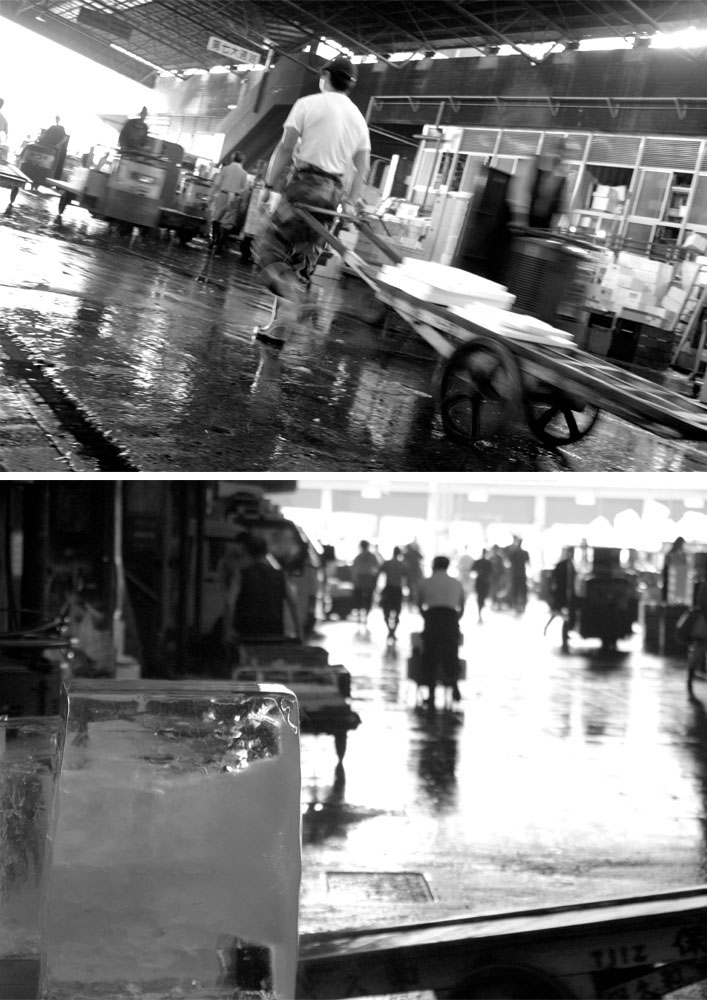

View from Sunshine Building, Ikebukuro
Just at the very beginning I found Tokyo huge, endless and chaotic. It very soon appeared that everything in the city-centre lies within walking distance. It even disappointed
me a bit.
Nevertheless, it’s an illusion that everything is so close. Nobody lives everywhere in large cities. We all live close to metro stations and our home blocks, after all. The burning wish to walk all routes in a strange city is nothing
more than just an attempt to lessen the chaos and enormity of strange and unfamiliar. It’s possible to compare this to trying to tame a wild animal.




Breakfast with Kobayashi Family, Nishi Sugamo
Kobayashi’s family duplex overlooks the highway. No wonder it’s noisy. On the other hand – who could afford
this apartment in Nish-Sugamo if it hadn’t been for the window on the street.
Grandma Keiko-san gets up before anyone else. She needs to prepare breakfast, get ready her grandson Ryo for school. She and her husband have a small family izakaya, which literally means “a drinking place.”
Ryo’s mother Mu-chan works in a fitness club and his father Yuma is a hair stylist working on Ginza.
this apartment in Nish-Sugamo if it hadn’t been for the window on the street.
Grandma Keiko-san gets up before anyone else. She needs to prepare breakfast, get ready her grandson Ryo for school. She and her husband have a small family izakaya, which literally means “a drinking place.”
Ryo’s mother Mu-chan works in a fitness club and his father Yuma is a hair stylist working on Ginza.




Kayabacho station, Tokyo Metro
How can one imagine Tokyo using just a single image ? The trains during the rush-hours, I suppose. It’s not that the trains are overcrowded, and people packed in carriages like sardines in a tin; this is quite a common thing. Think, however, of the orderly way they spread themselves along the platform. Platforms overcrowded, passengers hustling, sweating and hurrying, being late, and still queuing calmly and patiently.
Gaman - ability to endure - is the main dignity of Tokyo.
The City of Enduring.








Triton Square Office Towers, Kachidoki station
I always wanted to take a shot of a crowd of people walking into the offices at rush hour, but was never satisfied with the result. Taken from a flat surface the shot always looked like rows of people. Finally, I managed to find a point on the slope near the three gigantic office towers in Triton Square. I rejoiced when the viewfinder showed a dense crowd. This is how a crowd of office workers walking in the morning looks in reality.
















Sumo Stable Tayho-Beya, Kiyosumi-Shirakawa
- Sumo is quite popular, - tells me a young and very shy sumo apprentice Toho. - Whenever I go out somewhere in the city (sumo wrestlers must wear their traditional outfit everywhere), people all around me say “gambatte” (success) and take pictures, treat me with respect. They even want to touch me! We, the Japanese, have a belief that if one touches a sumo wrestler, especially in the beginning of the year - this year will be happy. But at the same time, the attitude to us is as to the people who live in a completely different world. When foreigners see us they probably think that we are out of samurai movies, only without the sword. Many believe that sumo wrestlers are harsh and threatening. This is because we are large, laconic and quiet. But talk to us, and you’ll realize that we’re just good guys! - laughs Toho.




You feel it at once, there’s something in the air beside jokes and the air of business. The boys are pushing each other: - You go now. – No, I don’t! You go!
Attention of a woman, my attention flatters them a lot.
I come up to them, Nice to meet you.
- My name is Yoshida, I’m eighteen, I’ve just left school, the boy tells me. His hair has just started to grow again. He feels embarrassed;
you see this as the guy is shifting from foot to foot.
- You may start sumo when you’re fifteen. Before this you’re examined by doctors and trainers to see if you’re healthy and fit enough to endure trainings.
Attention of a woman, my attention flatters them a lot.
I come up to them, Nice to meet you.
- My name is Yoshida, I’m eighteen, I’ve just left school, the boy tells me. His hair has just started to grow again. He feels embarrassed;
you see this as the guy is shifting from foot to foot.
- You may start sumo when you’re fifteen. Before this you’re examined by doctors and trainers to see if you’re healthy and fit enough to endure trainings.


- Are there some limits in terms the height and weight?
- Yes, of course! You are to be at least 5.8 feet tall and weigh at least 100 kilos. But you see we don’t all meet these demands. Each case is decided apart. My weight now is 140 kilos.
- Is it difficult to gain such a weight?
- Not that difficult, really. You just eat as much as you want, some boys eat one portion, some take ten, and I usually take two.
I’m from Toyama-Tan, it’s very beautiful there, there are mountains, and we live close to the Sea of Japan. Before I came to study here I had never lived in large cities,
let alone such a vast place as Tokyo. Everything seemed strange at first, I live in Tokyo, can you imagine? I have to wake up at five every day, we have trainings all the time, the discipline is very strict. My whole life has changed.
We hardly ever have time to enjoy ourselves. I’m at the bottom of rank now, so I may not go out into town. I sit and read comic strips. I’m reading ‘The Night King’, it’s a story about a women night club. The main character works at this club, he gets a new girlfriend each night. And I have no girlfriend now…
(An encounter with Night Kings is yet to happen, wait until it gets dark)
- Yes, of course! You are to be at least 5.8 feet tall and weigh at least 100 kilos. But you see we don’t all meet these demands. Each case is decided apart. My weight now is 140 kilos.
- Is it difficult to gain such a weight?
- Not that difficult, really. You just eat as much as you want, some boys eat one portion, some take ten, and I usually take two.
I’m from Toyama-Tan, it’s very beautiful there, there are mountains, and we live close to the Sea of Japan. Before I came to study here I had never lived in large cities,
let alone such a vast place as Tokyo. Everything seemed strange at first, I live in Tokyo, can you imagine? I have to wake up at five every day, we have trainings all the time, the discipline is very strict. My whole life has changed.
We hardly ever have time to enjoy ourselves. I’m at the bottom of rank now, so I may not go out into town. I sit and read comic strips. I’m reading ‘The Night King’, it’s a story about a women night club. The main character works at this club, he gets a new girlfriend each night. And I have no girlfriend now…
(An encounter with Night Kings is yet to happen, wait until it gets dark)


… Now, at eleven o’clock the training is finally over. The man on duty is strewing sand over the dohyo (battle arena) and sweeping it onto the middle of the ring, arranging a cone. A Shinto symbol is stuck into the heart of the cone. The ring is being strewn with salt in order to appease the dohyo spirits, thus praying for them to have their mercy upon the dohyo and sportsmen, and prevent traumas.


Elementary School, Kachidoki
By graduation, every Japanese student should know 1945 kanji by heart (each character has several readings). As soon as school is over, computers and mobile phones replace handwriting for most of the people. Very few people rely on their memory for writing these days.
An incident comes to mind. The action took place at the office of a company. A young employee Shimada Nobuharu makes a report and is trying to write the results of the meeting on a whiteboard. In the process, he repeatedly forgets how to write certain characters. He puffs, sighs and struggles with the pen. Colleagues advise him: “Nobu-san, write in hiragana!” Nobu-san writes in hiragana, a tidy line, like an elementary school student.




















Triton Square Office towers. Hibiya park
For everyone in Tokyo the lunch break starts at 12:00 sharp. The Prime minister and a five years old child begin to feel an urge to eat by noon every day.
Crowds of those wanting to have lunch are flooding the innumerable restaurants in the office towers, lining up beside trays selling obento, disperse in the nearby eateries and kombini where one can not only get a bento, but also leaf through endless magazines and manga books. The feeling of midday hunger equalizes all dwellers of Tokyo, me included.
Crowds of those wanting to have lunch are flooding the innumerable restaurants in the office towers, lining up beside trays selling obento, disperse in the nearby eateries and kombini where one can not only get a bento, but also leaf through endless magazines and manga books. The feeling of midday hunger equalizes all dwellers of Tokyo, me included.
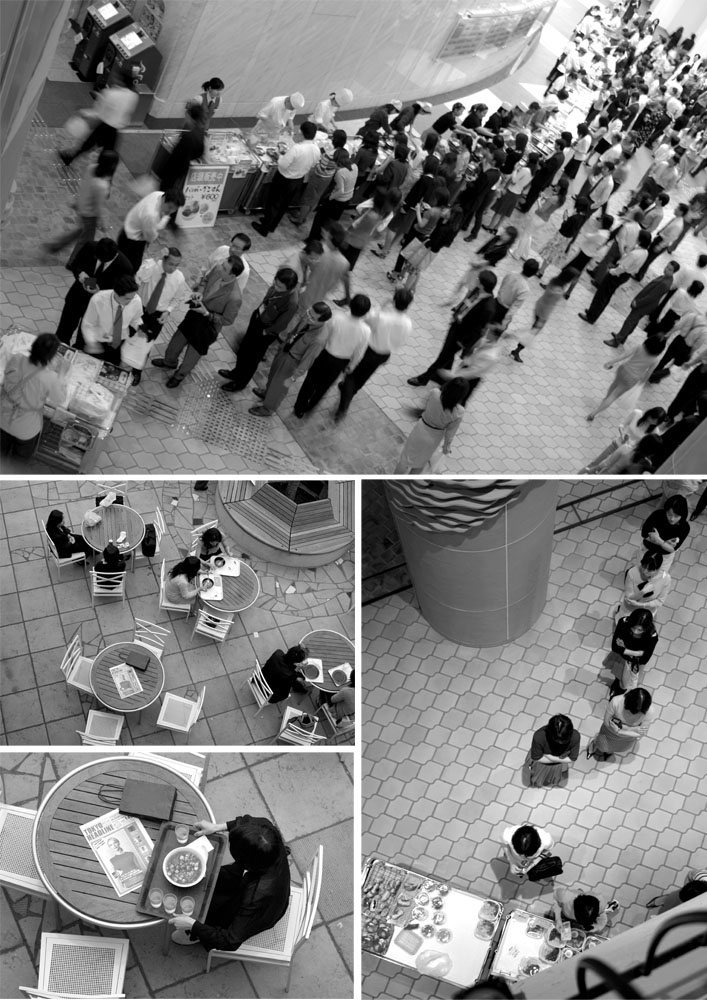



































View from Tokyo Sky Tree tower
If one looks at the map, it is immediately obvious that Tokyo has a direct relation to water: it is surrounded by the ocean, and the river Sumida flows through the center of the city. However, for foreigners Tokyo is not associated with water but rather with a “concrete jungle.” But for a Tokyoite, as a friend of mine says, Sumida “passes right through the heart”.
People think that Tokyo is a city of high technology and high rises. In reality, the residential areas mostly consist of two-story houses. These areas are the big inner provinces of an enormous city.


View from Tokyo Sky Tree tower
I live in Japan for ten years already. Whenever I travel abroad and meet with friends, they always expect me to tell them amusing stories about the “life on Mars.” But they are no longer satisfied: all that seemed strange to me in the beginning, has become familiar. Sky seen behind the overhead wires is the same as everywhere else. On the other hand Tokyo is constantly changing – every change of a season is expected by its residents as if for the first time. Everyday routine is diluted by the keen sense of permanent innovation. It is not boring. Therefore, I am still here, after ten years.




Sugamo
Three times a month - on 4th, 14th and 24th - the “market of the fourth day” is organized in Sugamo. Pilgrims, coming out of the temple, instantly turn into buyers of the local shops. But they did not come here just to pray to Jizo and purchase cheaply - they come to talk and have fun, to meet old friends and make new ones, to hang out. Sugamo is often called Obachan-no-Harajuku, meaning “Harajuku for grannies”: Harajuku is a notorious area where the most fashionable and youngest of Tokyo are hanging out.


















Monzen-Nakacho, playground
There is a strange Japanese tradition – young children are taken off the streets after five o’clock. One cannot see parents with small kids in the late hours in restaurants and cafes.
During day time, mothers are driving their children in strollers or on bicycles, walking them to the kindergartens, elementary schools, to playgrounds or parks, and then back home. In the evening, children are disappearing from the streets of the Japanese cities. Shops, restaurants and movie theaters are filled with adults.
Natural disasters and calamities are unpredictable in Japan; people never are.


Monzen-Nakacho, playground
Men and women - it seems so natural to insert an “and” conjunction between these words... Not so fast – we are in Japan, after all.
At a time when men are doing their “civic duty” - that is, spending all their time in the workplace, women return
their own debts: raising children, doing the housework,
helping the parents. Often times they see their husbands on rare occasions and spend their free time with other female friends, who are much more aware of their emotional needs than their own husbands.


Tsukudajima
This plum tree bonsai belongs to an old man who takes care of it every morning at 8:00am: if you walk on the street, you will see him swiping every leaf of the bonsai with a special cloth.




Yanaka
Yanaka is one of my favorite parts of Tokyo. I first saw the meaning of the word “reincarnation” here.
Behind a sakura tree alley on the both sides of the road is a Buddhist cemetery. In the middle of the cemetery there is a children’s playground: kids frolic as they would everywhere else, swinging on a swing. During the hanami holiday people are admiring cherry blossoms right at the foot of the monuments, drinking and having fun, enjoying the most beautiful Japanese holiday.
Delve into the area and go through the narrow streets, where low houses alternate with small Buddhist temples and the surrounding cemeteries, grocery shops, china shops, day care centers, restaurants, galleries, pottery shops. Life, death, life.
Behind a sakura tree alley on the both sides of the road is a Buddhist cemetery. In the middle of the cemetery there is a children’s playground: kids frolic as they would everywhere else, swinging on a swing. During the hanami holiday people are admiring cherry blossoms right at the foot of the monuments, drinking and having fun, enjoying the most beautiful Japanese holiday.
Delve into the area and go through the narrow streets, where low houses alternate with small Buddhist temples and the surrounding cemeteries, grocery shops, china shops, day care centers, restaurants, galleries, pottery shops. Life, death, life.


Homeless. Chuo Park, Ueno Park, Yoyogi Park
- I live an a box in Shinjuku... Why not in the park? I’m afraid of darkness, of ghosts. – he laughs. - I prefer it when there are people around, the lights and the traffic. So, I’m here, behind Takashimaya department store. I have friends here and it is always possible to leave my belongings with them. Also, I often put little things in a locker at the Southern exit of Shinjuku Station. A one hundred yen coin – and you have all the fun. More, you can get the coin back if you take your things before eight in the evening. That’s how I live. Myself in the box, my things in the locker. It turns out, all that I have in life by now can fit in a hundred yen box.














Ginza
Once Ginza was at the forefront of fashion. The first brick house, the first top hat and European costume, after
that - men with long hair and women in short skirts - reading Western novels, discussing Marxist literature.
Avant-garde gradually left the area and moved to Harajuku, Omotesando and Shibuya. Today’s main client of Ginza is a well-to-do elder women who have never read Marx, but are very familiar with the catalog of Tiffany.
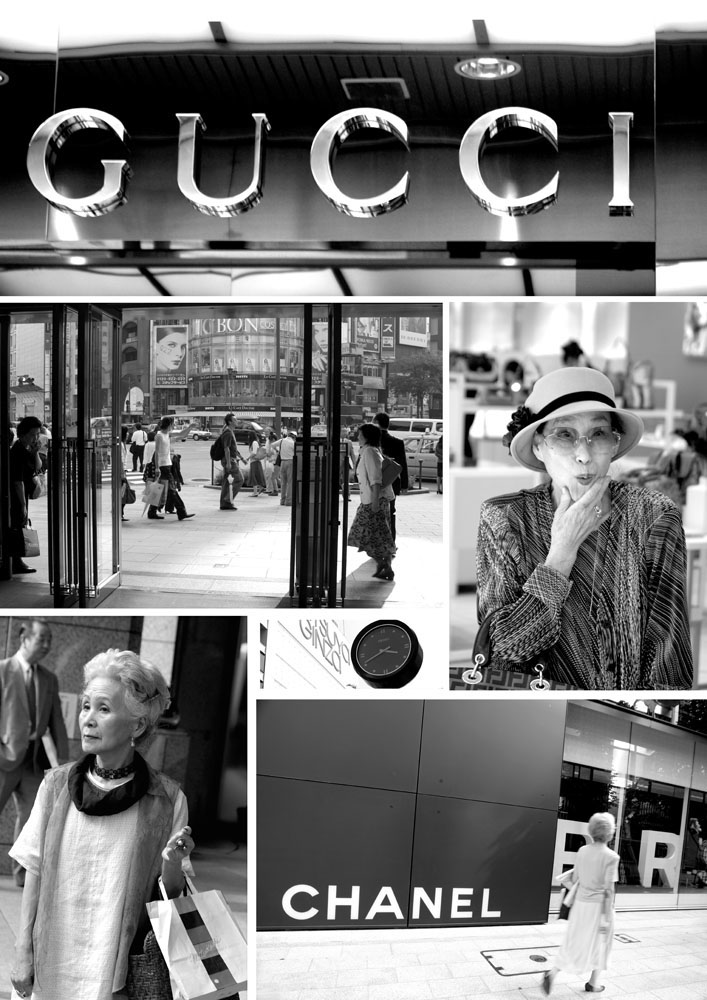

















Japanese “Lolitas”, Harajuku, Takeshita-dori
Moving along Takeshita-dori is never swift; you proceed slowly as you make your way through the dense colourful crowd. The stream of people is clenched between two rows of shops, slightly dissipating as the day is starting to fade away. My trip is aimed at having a talk with a true Lolita. I get the chance quite quickly as I set my eyes on a girl with white curls, dressed in rose. The girl is wearing detachable eyelashes and has a lace umbrella in her hand. I follow her. Ama rori takes the lift to the first floor of a two-storied building and enters the Body-Line shop, known as an economy-class Lolita boutique.
Prices for a dress here range from 30 to 80 dollars. You see the fake crystal chandeliers hanging down from the ceiling and dresses of all tints of rosy you can imagine. It’s the first time I see such a variety of laces and full skirts. Ama rori is pricing a dress in large ripe cherries.






Elvis Impersonators, Yoyogi Park
Elvis impersonators perform in Yoyogi park every Sunday. Everyone can come, see and take pictures. The followers of this subculture can buy all the necessary accessories in the nearby street’s shop. There is also a statue of the King. During the statue’s opening ceremony the former Prime minister of Japan Koizumi has cut the red ribbon – his brother is the president of the Elvis fan club.
Honestly speaking, I’m always amazed and at the same time feel respect for the people who treat such an unserious subject with such seriousness.
















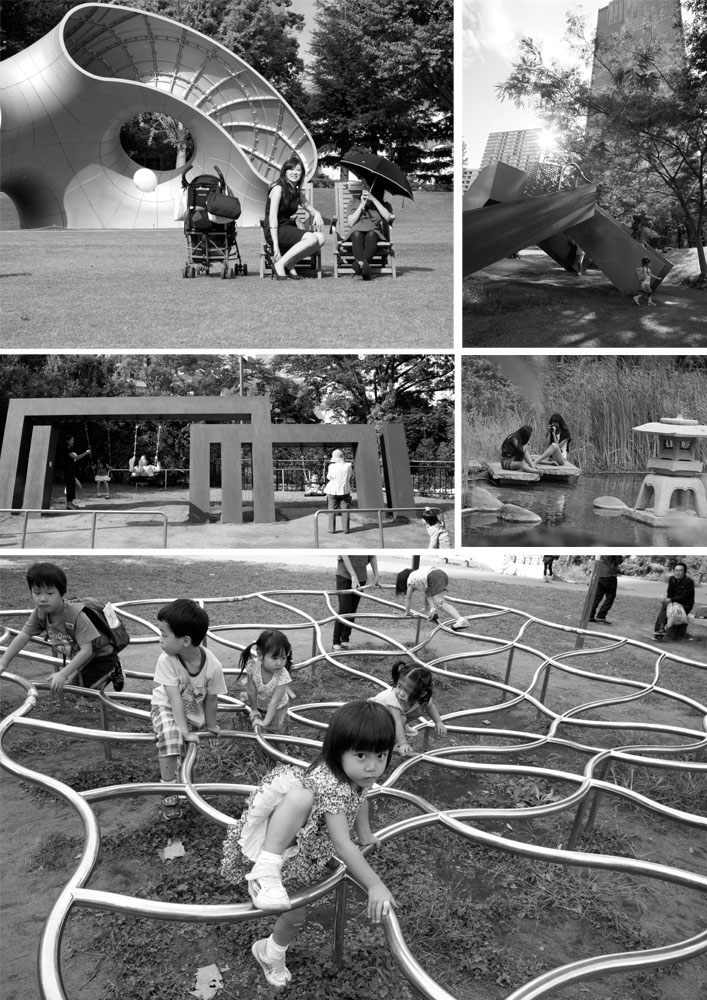



National Art Center, Roppongi
The architect of the National Art Center in Tokyo Kisho Kurosawa, refers to his creation as an “artistic airport”. There is no permanent collection in the museum: the variety of exhibitions arrive and then depart to other destinations.






Shibuya
Shibuya is an Everything-You-Wish-Place. It’s a business area and a trade center. Loads of offices in multi-storied blocks with glass walls, the largest department stores and shops in a row, book-shops, music stores, sport shops, ‘golf players’ paradise’, groceries, domestic appliances, make-up and bakeries...


...further there are giant TV screens, Tokyo Hands, Shibuya 109, Takashimaya. Armadas of people crowding along the streets and the homeless keeping aloof, and cafes, restaurants, takeaways and snack bars, so that you may think Tokyo does nothing but eat day and night. There are multilevel railroads with dashing trains. Pachinkos, rattling arcade game halls. Girls in high boots call for who-knows-what. Youth-only bars and cinemas for everyone. Ticket-offices. Travel agencies with posters portraying planes and palm trees, idyll seacoasts, heavy snows and sandy hills… 10%, 20%, 50% discounts! Just get into the plane and go where you dare to, but as far away from here as you can.








River City, View from Shinkawa
My first five years in Tokyo I lived near Tsukudajima. It was a 22-storey building standing on the bank of Sumida river. Cherry trees were planted along the coast. One spends a whole year in an unconscious anticipation of their bloom. Look out the window at the end of March and – wow! - the whole alley is covered by the gorgeous light pink sakura petals.




River City, the road to Tsukudajima
The road went from my house along the waterfront, and then across the bridge to Tsukudajima. Most often my appearance there was merely a pretext to feel permanence under my feet, bringing order to my thoughts and feelings. Some are engaged in jogging in the morning, some are in yoga. To me, starting a day was to walk along the waterfront and the winding alleys of Tsukudajima.


Dinner with the Tsuge family, Shinjuku
Beef, sizzling in a skillet in butter, slowly becoming a hambaga (hamburger), a salad of fresh vegetables is already cut - you only fill the sauce. Mother dissolves miso paste in a boiling water, adding seaweed and mashed tofu to the mix. Finely chopped green onions are next to the plate, and each one adds flavour to the resulting miso soup. Meanwhile rice is being cooked in the rice cooker by itself, and finally mother calls her daughters to help set the table. While the father of the Tsuge family is still at work as usual, we all are going to have a nice family dinner soon.






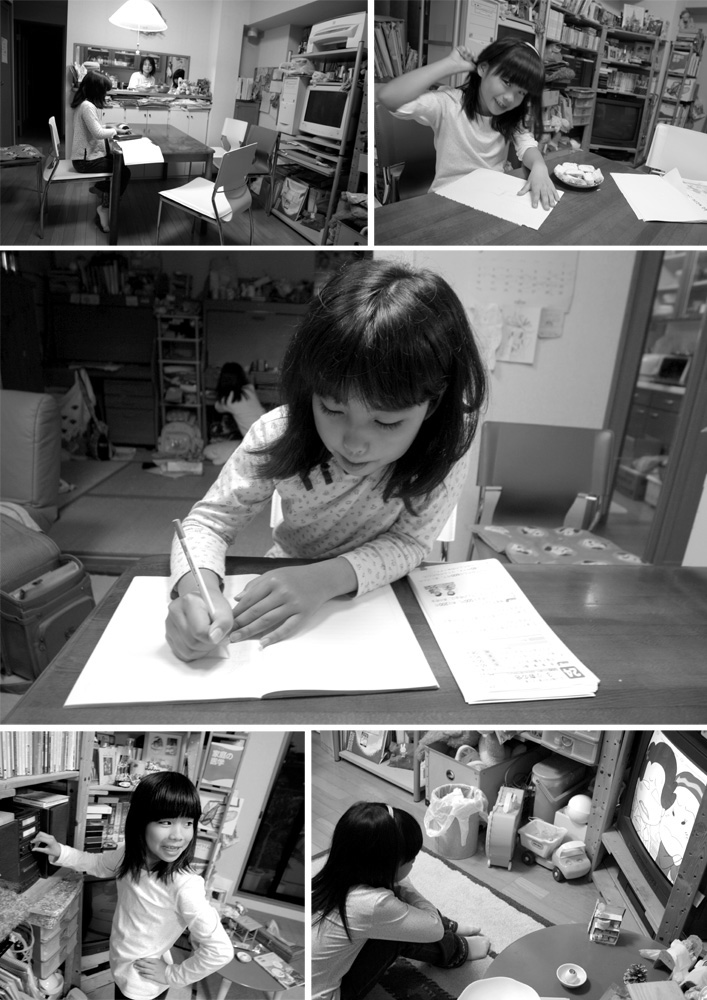







Street vendors, Yurakucho
A street shop owner arrives at his permanent place – a wooden trolley on wheels with a built-in broiler, shelter and some benches. He posts a red light with the names of his unsophisticated dishes, and begins to prepare: yaki-tori - skewers of chicken and giblets, yaku-soba - fried noodles with soy sauce, cabbage and spices or grilled octopus. This shop does not remain unnoticed for long: the employees of the nearby offices don’t want to miss a cheap drink and a snack. Now, as they are a little bit drunk and liberated, they don’t resemble themselves in the morning - rushing to the office sararimen.
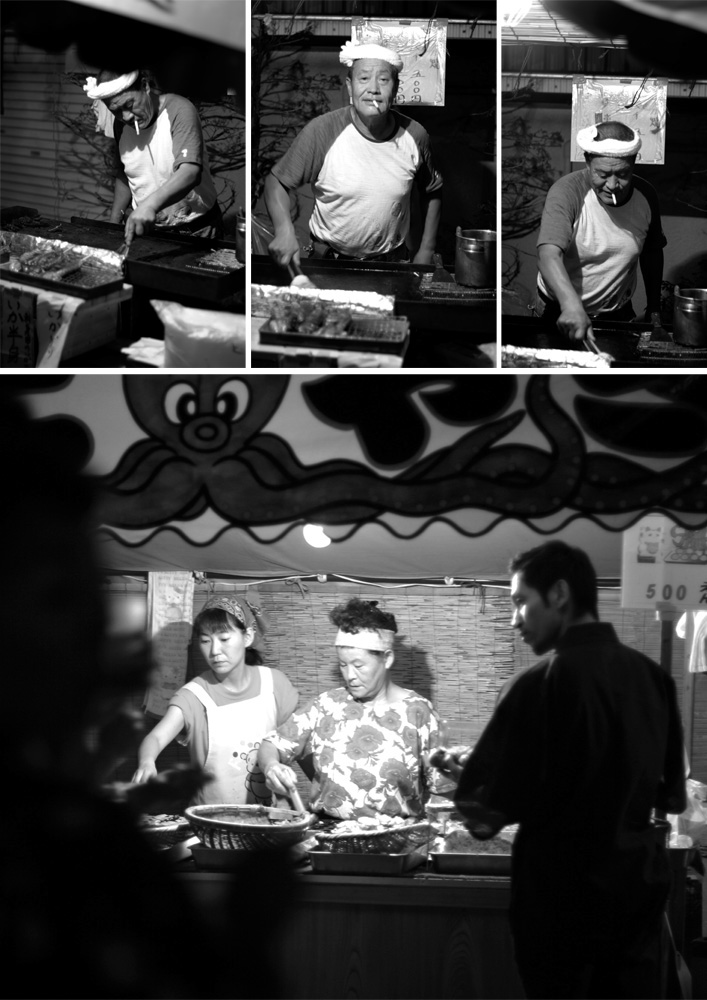















Shibuya
Once upon a time a friend came to visit me from Paris. He, like so many others, watched Kill Bill and Lost in Translation, read William Gibson’s Neuromancer and imagined Tokyo as a crazy glitter of neon lights and the huge screens covering the sky of “the color of television, tuned to a dead channel”. After wandering around in the low-rise residential areas, he started to wonder, where is this Tokyo which he knows ? But then we went to Shibuya full of advertising lights and his conception of Tokyo finally met reality: “So, this is where you are, the real Tokyo”, he said.






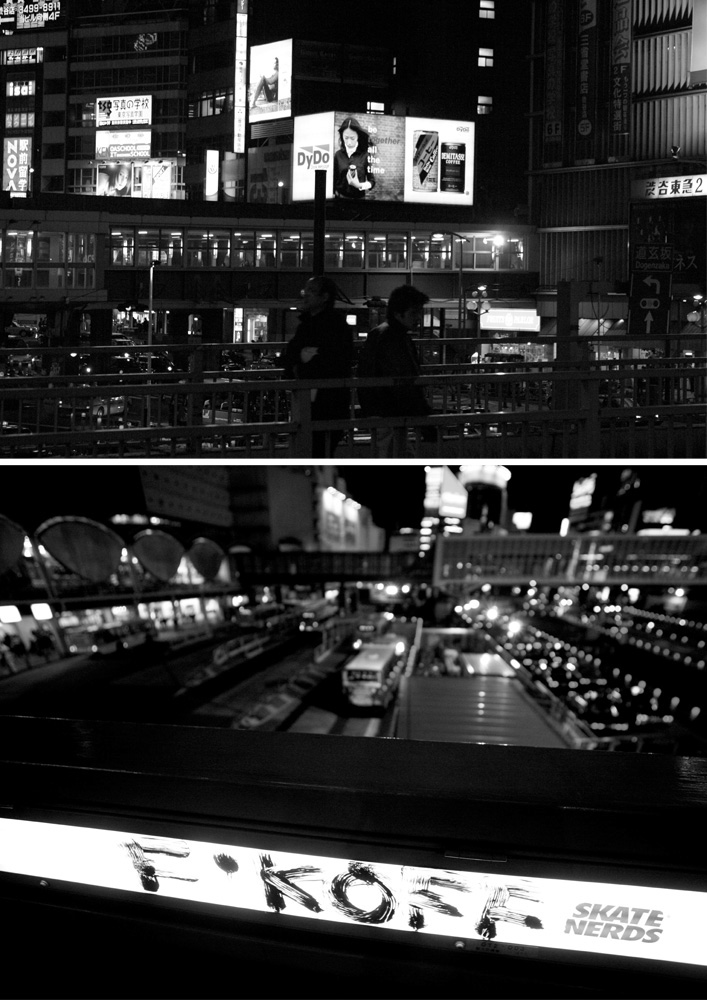



Dancing school on Monzen-Nakacho
Not everyone knows that Shall we dance with Richard Gere is an American remake of the Japanese film with the same name. And here I am – in a small dancing school located in a working class area of Tokyo near Monzen-Nakacho station. Everyone can join: the retired people, housewives, office workers – they invite each other to dance in order to escape from all the worries and enjoy the pleasure of music and movement. Not all of them possess an inherent charm of a glamorous Hollywood star, but their efforts attract me even more.










Elite hostess club, Ginza
Memoirs of a Geisha movie was just out, and the Foreign Correspondence club of Japan was abuzz with the news that Sonoda-san – a former geisha and the owner of an elite private hostess club in Ginza – will give a press conference there. Being a woman, I happened to be the only lucky photographer whom Sonoda-san has granted the entry to her sacred doors, when I asked for her permission after the meeting.
In the club, the former geisha mixes together a small cocktail of politicians, businessmen and famous artists. She married a local Akita prefecture official when she was not much older than twenty. Monotony of life in a small provincial town drove her into depression. She divorced her husband, having a vow not to ever marry again. The young women moved to the resort town of Atami, and became a geisha.
One of her patrons was willing to sponsor the opening of a nightclub at Ginza in Tokyo and she became its owner. Once she stepped onto the stage of Tokyo glitterati’s nightlife she never left it again.




Host club, Kabuki-cho
Host’s lifestyle leads to the quick fading, being twenty three the boys look as if they are in their thirties. They faint often; an ambulance is frequent at host bars. It happens sometimes, as soon as a boy has reached thirty
years old he goes to the hospital for kidney dialysis. These professional charges are by no means an excuse for skipping one’s working days, those leaving the bar in an ambulance are seen off with a phrase, See you tomorrow!


Love hotels, Kabuki-cho, Shinjuku
The first commuter will set off in two hours. Those kept in the centre of Tokyo will disperse to open 24 hours manga kisu’s to spend these hours in a cosy place with unlimited Internet access and rich library of comic strips and TV films, and enjoy their tea and coffee, all this for a small fee. Do you want to fresh up and take a shower? It will cost you extra 10 dollars. The others will check in for a night in tiny hotels, provided they have a free place for you. One Tokyo dweller long space with a small TV set and a curtain will be granted for you for 30 dollars, the curtain protecting your shelter from strange eyes until you’ll be woken up by your neighbour’s alarm clock. Those lucky to be together this night may go hand in hand to the hourly paid Love Hotel. Rooms there are booked automatically, so that no human eye will see you away. Book a room in a vampire style, decorated as a sea bottom or Winnie-the-Pooh’s hole, and come on, do what you want. All the rooms are perfectly isolated, you won’t be overheard. Or you may simply flop onto starched linen and helplessly fall asleep. Those who have neither money nor strength to drag themselves to some oasis of civilization will lean against the wall of a snack bar at the station. The doors and windows there are drawn with blinds. You have not that much time to wait for the first commuter … You can hear Tokyo dwellers lament over the times changing to worse after watching criminal news. Anyway, they are not afraid of spending the night in the street.
The wind has brought some pieces of rubbish, beer canes and old newspapers. The sleep is carrying away the most notorious late sleepers. Their eyelids are getting still heavier. The day has come to an end.




